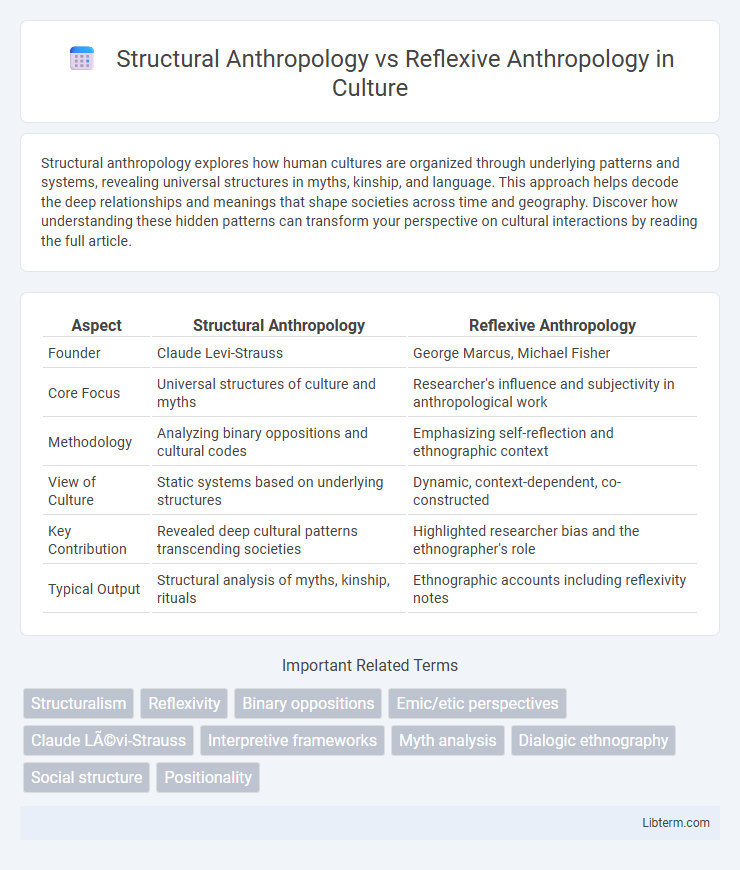Structural anthropology explores how human cultures are organized through underlying patterns and systems, revealing universal structures in myths, kinship, and language. This approach helps decode the deep relationships and meanings that shape societies across time and geography. Discover how understanding these hidden patterns can transform your perspective on cultural interactions by reading the full article.
Table of Comparison
| Aspect | Structural Anthropology | Reflexive Anthropology |
|---|---|---|
| Founder | Claude Levi-Strauss | George Marcus, Michael Fisher |
| Core Focus | Universal structures of culture and myths | Researcher's influence and subjectivity in anthropological work |
| Methodology | Analyzing binary oppositions and cultural codes | Emphasizing self-reflection and ethnographic context |
| View of Culture | Static systems based on underlying structures | Dynamic, context-dependent, co-constructed |
| Key Contribution | Revealed deep cultural patterns transcending societies | Highlighted researcher bias and the ethnographer's role |
| Typical Output | Structural analysis of myths, kinship, rituals | Ethnographic accounts including reflexivity notes |
Introduction to Structural Anthropology
Structural Anthropology, pioneered by Claude Levi-Strauss, analyzes cultural phenomena through underlying structures such as myths, kinship, and language, emphasizing universal patterns shaping human thought. This approach contrasts with Reflexive Anthropology, which prioritizes the anthropologist's self-awareness and the interaction between observer and subject within ethnographic research. An introduction to Structural Anthropology highlights its basis in structural linguistics and the search for binary oppositions that inform cultural narratives and social organization.
Core Principles of Structural Anthropology
Structural Anthropology, founded by Claude Levi-Strauss, emphasizes the analysis of underlying structures in human culture, especially binary oppositions that shape myths, kinship, and language. It posits that universal cognitive patterns govern cultural phenomena, revealing deep-seated mental structures common to all societies. Reflexive Anthropology, by contrast, centers on self-awareness and the ethnographer's role, prioritizing subjectivity and the dynamics between observer and observed.
Key Figures in Structural Anthropology
Structural Anthropology, pioneered by Claude Levi-Strauss, emphasizes analyzing cultural phenomena through underlying structures such as myths, kinship, and language patterns, arguing these universal systems shape human societies. Key figures like Levi-Strauss introduced binary oppositions as fundamental to understanding cultural meaning, influencing disciplines beyond anthropology. Reflexive Anthropology, contrastingly explored by scholars like Clifford Geertz, centers on the interpretation of cultural symbols within their specific contexts and the researcher's subjectivity.
Introduction to Reflexive Anthropology
Reflexive Anthropology emphasizes the self-awareness of the anthropologist's influence on research, contrasting with Structural Anthropology, which analyzes underlying cultural patterns and social structures. Reflexive methods critically examine the interaction between observer and observed, highlighting subjectivity and ethical considerations in ethnographic practice. This approach fosters a deeper understanding of how cultural knowledge is co-constructed during fieldwork.
Core Principles of Reflexive Anthropology
Reflexive Anthropology emphasizes the critical examination of the anthropologist's own role, biases, and influence within the research process, promoting self-awareness and ethical accountability. It challenges the objective stance assumed by Structural Anthropology, which focuses on identifying universal patterns and structures in human cultures. By integrating reflexivity, anthropologists seek to produce more nuanced, context-sensitive interpretations that acknowledge their positionality in knowledge production.
Key Figures in Reflexive Anthropology
Reflexive anthropology emphasizes critical self-awareness and the impact of the anthropologist's presence on research, with key figures including Clifford Geertz, known for interpretive anthropology and thick description, and James Clifford, who challenged traditional ethnographic authority and highlighted the constructed nature of ethnographic texts. George Marcus pioneered multi-sited ethnography, expanding reflexive approaches by examining complex social networks across various locations. These scholars collectively advanced reflexive anthropology by prioritizing subjectivity, context, and ethical considerations within anthropological practice.
Methodological Differences: Structure vs. Reflexivity
Structural Anthropology emphasizes analyzing underlying cultural systems and binary oppositions through fixed frameworks and patterns. Reflexive Anthropology prioritizes the anthropologist's self-awareness, incorporating personal biases and the co-construction of knowledge between researcher and subjects. Methodologically, Structural Anthropology relies on objective analysis of cultural structures, whereas Reflexive Anthropology employs critical reflection on the researcher's influence and positionality within the fieldwork.
Comparing Analytical Approaches
Structural Anthropology analyzes cultural phenomena by identifying underlying universal structures and patterns, often using binary oppositions as key analytical tools. Reflexive Anthropology prioritizes the anthropologist's self-awareness and critically examines how their presence and perspective influence the research process and interpretation of cultural practices. Comparing these approaches highlights Structural Anthropology's emphasis on objective, cross-cultural frameworks versus Reflexive Anthropology's focus on subjective experience and ethical considerations in ethnographic analysis.
Critiques and Debates: Structuralism vs. Reflexivity
Structural anthropology, pioneered by Claude Levi-Strauss, faces critiques for its deterministic assumptions and underemphasis on individual agency, whereas reflexive anthropology emphasizes self-awareness and the researcher's influence on knowledge production. Debates center on structuralism's search for universal patterns in myths and kinship being challenged by reflexive approaches that highlight cultural specificity and the dynamic interaction between anthropologist and subject. This tension reflects broader disciplinary concerns about balancing objectivity with the recognition of ethnographic subjectivity and power relations in knowledge construction.
Contemporary Relevance and Future Directions
Structural Anthropology, pioneered by Claude Levi-Strauss, emphasizes universal patterns and deep structures underlying human culture, offering tools for analyzing mythology, kinship, and social systems. Reflexive Anthropology, emerging in the late 20th century, prioritizes self-awareness and the ethnographer's impact, fostering more ethical and participatory research methods in diverse cultural contexts. Contemporary relevance lies in integrating both approaches to address global cultural dynamics, with future directions aiming to enhance interdisciplinary collaboration and digital ethnography for richer, more nuanced cultural insights.
Structural Anthropology Infographic

 libterm.com
libterm.com